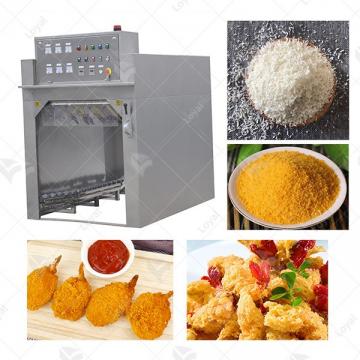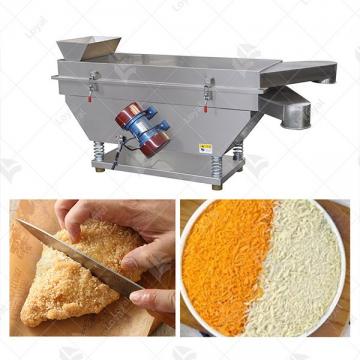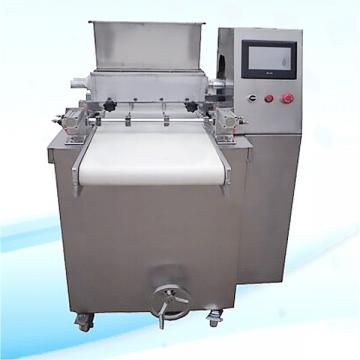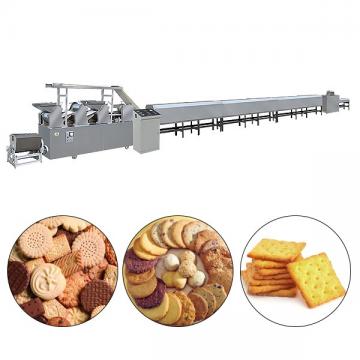
- Shandong Loyal Industrial Co.,Ltd.
- Macaroni Production Machine Instant Noodle Machine Biscuit Making Machine
Home> Company News> Everything You Need To Know About Puff Snack Extruder

Everything You Need To Know About Puff Snack Extruder
2025-04-29 10:26:37Introduction to Puff Snack Extruder
The puff snack extruder stands as a cornerstone of modern food manufacturing, transforming raw agricultural commodities—such as corn, rice, wheat, and potatoes—into the light, crispy, and irresistibly airy snacks beloved globally. This sophisticated machinery operates on the principle of thermomechanical processing, combining heat, pressure, and shear forces to cook, expand, and shape raw materials into a vast array of puffed snack products. Historically, the advent of extrusion technology in the mid-20th century revolutionized snack production by replacing labor-intensive frying or baking methods with a continuous, automated process capable of achieving unprecedented consistency and efficiency. Today, the puff snack extruder not only dominates mainstream snack markets but also drives innovation in health-focused and niche categories, including high-protein, gluten-free, and plant-based alternatives. Its adaptability to diverse formulations, coupled with energy-efficient designs, positions it as a critical asset for manufacturers striving to meet evolving consumer demands for convenience, taste, and nutritional value.

Core Components and Working Mechanism of a Puff Snack Extruder
1.1 Mechanical Structure Breakdown
A puff snack extruder is a sophisticated food-processing machine engineered to transform raw ingredients (e.g., corn, rice, wheat, or potato starch) into aerated, crispy snacks through a combination of heat, pressure, and mechanical shear. Its core components include:
- Feeding System:
- A volumetric or gravimetric feeder ensures precise ingredient dosing, maintaining consistency in texture and flavor. Modern extruders often integrate sensors to adjust flow rates dynamically, reducing waste and improving product uniformity.
- Barrel & Screw Design:
- The barrel, typically made of corrosion-resistant stainless steel, houses a co-rotating or counter-rotating twin-screw system. The screws’ geometry (e.g., flight pitch, kneading blocks) determines mixing efficiency and residence time, critical for achieving ideal dough hydration and gelatinization.
- Example: A deep-flight screw section enhances material conveyance, while a reverse-pitch segment intensifies mixing, ideal for high-fiber formulations.
- Die Heads:
- Customizable die plates with holes of varying shapes (e.g., circular, star-shaped) define the snack’s cross-section. Advanced extruders use quick-change dies to reduce downtime during product transitions.
- Cutting Unit:
- A rotary knife or ultrasonic cutter synchronizes with the extrusion speed to ensure uniform length and minimal product deformation.
1.2 Step-by-Step Extrusion Process
The operation of a puff snack extruder follows a structured four-phase workflow:
- Mixing & Preconditioning:
- Dry ingredients (flour, seasonings) and liquids (water, oil) are blended in a preconditioner, achieving 25–35% moisture content. This step initiates starch gelatinization and protein denaturation, preparing the dough for extrusion.
- Cooking & Shearing:
- Inside the heated barrel (120–180°C), friction and steam injection cook the dough while the screws apply mechanical shear. This dual-action expands the starch’s molecular structure, creating a viscoelastic melt.
- Shaping & Expansion:
- The molten dough exits the die under high pressure (50–150 bar). Sudden pressure drop triggers water vaporization, causing the snack to puff and solidify into its characteristic porous structure.
- Drying & Cooling:
- Post-extrusion, snacks pass through a multi-stage dryer to reduce moisture to 2–4%, ensuring crispiness and shelf stability. Cooling tunnels stabilize the product’s texture before packaging.
1.3 Critical Parameters for Optimal Puffing
Achieving consistent puff quality hinges on controlling three variables:
- Temperature:
- Barrel zones are heated incrementally (120°C feed zone → 180°C die zone) to ensure gradual starch gelatinization. Overheating risks dough degradation, while underheating leads to poor expansion.
- Pressure:
- Die pressure directly influences puff volume. Higher pressures (120–150 bar) create finer cells, ideal for light, airy snacks, whereas lower pressures (80–100 bar) yield denser textures.
- Moisture Content:
- Optimal moisture (28–32%) balances dough plasticity and expansion. Excessive moisture causes die blockages, while insufficient moisture results in brittle, unevenly puffed snacks.
1.4 Innovations in Extruder Design
Modern puff snack extruders incorporate advanced features to enhance efficiency:
- Co-extrusion Technology:
- Dual-barrel systems allow simultaneous injection of core fillings (e.g., cheese, chocolate) into hollow snacks, expanding product diversity.
- Energy Recovery Systems:
- Heat exchangers recycle steam from the cooling stage to preheat the preconditioner, reducing energy consumption by 15–20%.
- AI-Driven Process Control:
- Machine learning algorithms analyze real-time data (pressure, torque, temperature) to predict and correct deviations, ensuring batch-to-batch consistency.
Conclusion
The puff snack extruder is a cornerstone of modern snack manufacturing, blending mechanical precision with thermal control to deliver products that meet evolving consumer demands for taste, texture, and nutrition. By mastering its core components and process dynamics, manufacturers can unlock new opportunities in the $120 billion global snack market.

Types of Puff Snack Extruders: Single-Screw vs. Twin-Screw
To optimize production efficiency and adapt to diverse snack formulations, manufacturers must choose between single-screw and twin-screw puff snack extruders. Below is a structured comparison highlighting their designs, capabilities, and applications.
Comparison Table: Single-Screw vs. Twin-Screw Puff Snack Extruders
|
Feature |
Single-Screw Puff Snack Extruder |
Twin-Screw Puff Snack Extruder |
|
Mechanical Design |
Uses a single, helical screw rotating within a stationary barrel. |
Employs two intermeshing screws (co-rotating or counter-rotating) for enhanced mixing. |
|
Mixing Capability |
Limited shear force; relies on barrel friction for blending. Less effective for high-fiber/protein blends. |
High shear zones and self-wiping screw flights ensure uniform mixing, ideal for complex formulations. |
|
Energy Efficiency |
Lower energy consumption (10–15% less than twin-screw) due to simpler design. |
Higher energy use but offset by reduced raw material waste and faster throughput. |
|
Throughput Capacity |
Suitable for low-to-medium output (100–500 kg/hr); ideal for artisanal or regional producers. |
Supports high-volume production (500–2,000 kg/hr+); preferred for industrial-scale operations. |
|
Product Versatility |
Best for basic puffed snacks (e.g., corn curls, cheese puffs) with standard recipes. |
Handles premium snacks (e.g., high-protein puffs, gluten-free crisps) and co-extruded products. |
|
Maintenance Complexity |
Fewer moving parts reduce downtime; cleaning is straightforward. |
Requires specialized training for screw/barrel maintenance but offers modular replaceability. |
|
Cost Structure |
Lower upfront investment (20–30% cheaper than twin-screw) but higher long-term inefficiency costs. |
Higher initial cost but justifiable via ROI from reduced waste and higher output. |
|
Common Applications |
Basic cereal puffs, simple seasoned snacks, and low-moisture formulations. |
Fortified snacks, plant-based puffs, and products requiring precise texture control. |
2.1 When to Opt for a Single-Screw Puff Snack Extruder
- Budget-Conscious Operations: Ideal for startups or small-scale producers prioritizing affordability.
- Simplified Recipes: Best suited for snacks with straightforward ingredient lists (e.g., 80% corn grits + 20% flavoring).
- Low Maintenance Requirements: Minimal technical expertise needed for routine upkeep.
2.2 Advantages of a Twin-Screw Puff Snack Extruder
- High-Fiber/Protein Formulations: The twin-screw design’s superior mixing prevents ingredient separation in snacks with >15% dietary fiber or protein.
- Co-Extrusion Capability: Enables the simultaneous production of filled snacks (e.g., hollow cheese puffs with a creamy core).
- Reduced Batch-to-Batch Variability: AI-driven process controls ensure consistent texture, color, and puff volume.
2.3 Hybrid Models: Bridging the Gap
Some manufacturers offer hybrid extruders combining:
- A single-screw feeding section for cost-effective ingredient conveyance.
- A twin-screw cooking/shaping zone for advanced formulation flexibility.
Example: A hybrid machine might process 70% corn flour via a single screw and 30% pea protein isolate via a twin-screw section, balancing affordability and performance.
2.4 Market Trends Influencing Extruder Selection
- Health-Driven Demand: Twin-screw extruders dominate the high-protein snack sector (projected to grow 9% CAGR by 2028).
- Sustainability Goals: Single-screw models are gaining traction in eco-conscious regions due to their lower energy footprint.
- Automation Integration: Twin-screw extruders’ compatibility with Industry 4.0 systems (e.g., predictive maintenance) appeals to multinational snack brands.

Applications Across Snack Categories
The versatility of the puff snack extruder has revolutionized snack manufacturing, enabling producers to innovate across traditional, health-focused, and niche markets. Below is a structured breakdown of its applications:
2.1 Traditional Puffed Snacks: Cornerstone of the Industry
The puff snack extruder dominates production of classic favorites, leveraging its ability to transform staple grains into crispy, airy textures. Key applications include:
- Corn-Based Snacks:
- Example: Cheese puffs, nacho rings, and corn curls rely on the extruder’s capacity to create porous, crunchy structures from cornmeal. Twin-screw extruders excel here due to their high-shear mixing, ensuring uniform flavor distribution and puffing.
- Rice-Based Products:
- Application: Puffed rice snacks, often flavored with turmeric, chili, or coconut, leverage the extruder’s precision in moisture control to achieve delicate textures without overcooking.
- Wheat & Potato Snacks:
- Innovation: Extruders enable the creation of “pillow-shaped” wheat puffs and potato-based “crisps” with reduced oil absorption, appealing to cost-sensitive markets.
2.2 Health-Conscious Alternatives: Meeting Modern Nutritional Demands
Consumer shifts toward clean-label, nutrient-dense snacks have driven extruder technology into specialized applications:
- High-Protein Puffs:
- Process: Extruders blend pea, soy, or whey protein isolates with grains to create snacks with 10–20g protein per serving. The twin-screw design’s thermal control prevents protein denaturation, preserving solubility and texture.
- Gluten-Free & Vegan Options:
- Ingredients: Quinoa, buckwheat, and chickpea flour are processed in extruders with dedicated allergen-free zones. The extruder’s die geometry ensures uniform puffing despite the absence of gluten, a notorious challenge in plant-based formulations.
- Fortified Snacks:
- Additives: Vitamins (B12, D3), minerals (iron, zinc), and probiotics are injected post-extrusion via co-extrusion heads. This process requires precise temperature regulation to maintain bioactivity.
2.3 Niche Markets: Tailoring Snacks for Emerging Trends
The puff snack extruder’s adaptability has unlocked opportunities in premium and specialized segments:
- Organic & Non-GMO Snacks:
- Certification: Extruders designed for organic processing use food-grade lubricants and stainless steel components to comply with USDA/EU organic standards. The quick-change die system allows seamless transitions between conventional and organic batches.
- Low-Calorie & Sugar-Free Options:
- Innovation: Extruders process sweeteners like stevia or erythritol alongside fiber-rich ingredients (inulin, psyllium) to create snacks with 30% fewer calories. The dual-barrel co-extrusion system separates sweet core fillings from savory shells, reducing sugar content without sacrificing taste.
- Exotic-Flavored & Ethnic Snacks:
- Global Trends: From Japanese matcha-flavored puffs to Mexican chili-lime corn chips, extruders accommodate diverse flavor profiles through adjustable die shapes and post-extrusion seasoning drums.
2.4 Emerging Applications: Beyond Grains
Recent advancements in extruder design have expanded their use beyond traditional grains:
- Insect-Based Proteins:
- Sustainability: Extruders process cricket or mealworm flour into high-protein snacks with neutral flavor profiles. The twin-screw system’s high-shear mixing masks earthy notes, making insect-based snacks palatable to mainstream audiences.
- Pulses & Legumes:
- Nutrition: Lentil, chickpea, and black bean extrudates offer gluten-free, fiber-rich alternatives. The extruder’s preconditioning step ensures proper hydration of legume flours, preventing brittleness.
- Algae & Seaweed:
- Innovation: Spirulina- or kelp-enriched snacks leverage the extruder’s ability to incorporate micro-powders without clogging. These snacks target the $15 billion superfood market, appealing to health-conscious millennials.
2.5 Market Drivers & Future Potential
The puff snack extruder’s adaptability aligns with key industry trends:
- Convenience: On-the-go snacks, including mini-sized puffs and single-serve packs, leverage the extruder’s high throughput (up to 500 kg/hour).
- Clean Labels: Consumers demand transparency, driving extruders to process “clean” ingredients without artificial additives.
- Customization: 3D-printed dies and AI-driven recipe optimization enable manufacturers to launch personalized snacks rapidly.

Advantages of Using a Puff Snack Extruder
In the dynamic landscape of industrial food processing, the puff snack extruder stands out as a cornerstone machine for manufacturers aiming to produce high-quality, cost-effective, and versatile puffed snacks. This equipment leverages advanced extrusion technology to transform raw ingredients into light, crispy, and visually appealing products with minimal effort. Below are the key advantages that make the puff snack extruder an indispensable asset in modern food production lines.
1. High Production Efficiency and Throughput
One of the most significant benefits of a puff snack extruder is its ability to achieve high-speed, continuous operation. Unlike traditional batch-processing methods, extrusion technology enables manufacturers to produce large volumes of snacks in a fraction of the time. The machine’s design, featuring a screw-driven barrel and precision-engineered die heads, ensures uniform mixing, cooking, and shaping of ingredients under controlled temperature and pressure conditions. This results in a consistent output rate, often exceeding several hundred kilograms per hour, depending on the model and configuration.
For industrial-scale operations, this efficiency translates to reduced labor costs, shorter production cycles, and the ability to meet fluctuating market demands without compromising quality.
2. Versatility in Product Formulation
The puff snack extruder excels in accommodating a wide range of raw materials, including corn, rice, wheat, potato, and even alternative grains like quinoa or lentils. Its adaptive extrusion process allows manufacturers to experiment with ingredient blends, moisture levels, and additives (such as flavors, colors, or nutritional enhancers) to create diverse product lines.
For instance:
- Classic puffed snacks (e.g., cheese curls, corn puffs)
- Multigrain or high-fiber variants targeting health-conscious consumers
- Sweet or savory coated products (e.g., chocolate-covered puffs)
- Fortified snacks enriched with vitamins or minerals
This flexibility enables companies to pivot quickly to emerging trends, such as plant-based or gluten-free snacks, without requiring major equipment overhauls.
3. Consistent Product Quality and Texture
Achieving uniformity in puffed snacks is critical for brand reputation and consumer satisfaction. The puff snack extruder ensures this through precise control over extrusion parameters, including:
- Temperature regulation (to avoid overcooking or undercooking)
- Screw speed adjustments (to modify density and expansion)
- Die head design (to influence shape, size, and porosity)
The result is snacks with a consistent crunch, uniform color, and predictable texture, whether produced in small batches or at full industrial capacity. This reliability minimizes waste and rework, directly impacting profitability.
4. Energy Efficiency and Cost Savings
Modern puff snack extruders are engineered with energy-efficient components, such as insulated barrels, variable-frequency drives, and optimized heat exchangers. These features reduce power consumption while maintaining peak performance. Additionally, the extrusion process minimizes ingredient loss—unlike frying or baking, which can lead to shrinkage or uneven cooking.
For manufacturers, this translates to:
- Lower utility bills
- Higher raw material yield
- Reduced carbon footprint (a growing priority in global food supply chains)
5. Hygiene and Food Safety Compliance
In an era of stringent food safety regulations, the puff snack extruder is designed with sanitation-first principles. Key features include:
- Stainless steel construction to resist corrosion and bacterial growth
- Tool-less disassembly for easy cleaning and maintenance
- Sealed extrusion chambers to prevent contamination
These attributes simplify compliance with standards like HACCP, FDA, and BRCGS, ensuring products meet global market requirements.

Challenges in Puff Snack Extrusion
The puff snack extrusion process, while highly efficient for producing a wide range of popular snacks, presents several technical and operational challenges that manufacturers must navigate to ensure product quality, consistency, and cost-effectiveness. As an industrial food machinery expert, I have identified three primary areas where these challenges commonly arise: material handling, process control, and energy efficiency.
1. Material Handling Complexities
One of the most significant hurdles in puff snack extrusion lies in managing raw material variability. The performance of a puff snack extruder hinges on the precise blending of ingredients such as corn grits, rice flour, or potato starch, which often differ in moisture content, particle size, and protein levels. Inconsistent feedstock can lead to issues like uneven expansion during extrusion, resulting in snacks with irregular shapes, densities, or textures. For instance, excess moisture may cause blistering or collapse, while insufficient moisture can produce overly dense, unappealing products. Additionally, foreign particles or impurities in the raw materials can damage screw components or block die openings, disrupting production continuity.
2. Process Control Precision
Achieving optimal product attributes—such as crispness, porosity, and flavor retention—requires meticulous control over extrusion parameters. Variables like barrel temperature, screw speed, and die geometry must be calibrated within narrow ranges to balance mechanical energy input and thermal effects. Overheating, for example, can degrade starches or sugars, leading to off-flavors or burnt textures. Conversely, inadequate heat may fail to activate the necessary gelatinization or expansion mechanisms. Furthermore, sudden pressure fluctuations in the extruder barrel—often caused by inconsistent feeding rates or sudden valve adjustments—can trigger "surging," a phenomenon where product output becomes erratic, compromising both quality and throughput.
3. Energy Consumption and Sustainability
The high-energy demands of puff snack extrusion pose both economic and environmental concerns. Traditional extruders typically rely on electric heaters or steam injection systems to maintain barrel temperatures, consuming substantial power. Inefficient thermal management or poorly insulated machinery exacerbates energy losses, driving up operational costs. Moreover, as the food industry faces increasing pressure to reduce carbon footprints, optimizing the puff snack extruder’s energy efficiency has become a critical priority. Manufacturers must balance productivity goals with sustainability targets, often requiring upgrades to advanced drive systems, heat recovery technologies, or alternative energy sources.
To address these challenges, innovative solutions—ranging from intelligent automation to advanced materials science—are reshaping the puff snack extrusion landscape. The next section will explore actionable strategies to mitigate these issues while enhancing productivity and product quality.
Reference
Here are five authoritative foreign websites related to industrial food machinery, along with their URLs:
1.ThomasNet
Website: https://www.thomasnet.com
2.MachineryTrader
Website: https://www.machinerytrader.com
3.Food Engineering:https://www.foodengineeringmag.com
4.Pack Expo:https://www.packexpo.com
5.DirectIndustry:https://www.directindustry.com
 Commercial Japanese Panko Bread Crumb Grinder Machine
Commercial Japanese Panko Bread Crumb Grinder Machine Japanese Bread Crumbs Processing Line
Japanese Bread Crumbs Processing Line Automatic Cookies Making Machines
Automatic Cookies Making Machines Fully Automatic Biscuit Making Machines
Fully Automatic Biscuit Making Machines